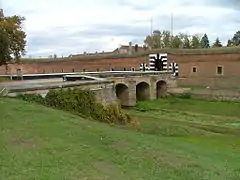Small Fortress (Terezín)
The Small Fortress (Czech: Malá pevnost, German: Kleine Festung) is a fortress forming a significant part of the town of Terezín in the Czech Republic. This initially military fortress was established at the end of the 18th century together with the whole town of Terezín on the right bank of the Ohře river. It served as a prison already in the 19th century.

World War I
During World War I the fortress served as a prison for the opponents of the Austro-Hungarian monarchy. During the war, Serbian nationalist Gavrilo Princip, assassin of Archduke Franz Ferdinand of Austria, was imprisoned here. Princip died after nearly four years in the prison on 28 April 1918 on tuberculosis.[1]
World War II
_01.JPG.webp)
During World War II, the fortress served as a prison of Prague Gestapo since 10 June 1940 until May 1945. It was the largest prison in the Protectorate of Bohemia and Moravia. Unlike the Terezín Ghetto, where the Jews were imprisoned, the Small Fortress served as a prison for the political opponents of the Nazi German regime, Czech resistance members, some British POWs, and other people from the Soviet Union, Yugoslavia, France, Italy etc. Throughout the operation of the Gestapo prison, around 32,000 people (including 5,000 women) were incarcerated here.[2]
Executions in the fortress were carried out from 1943, based on the Sonderbehandlung treatment. In total more than 250 prisoners were executed here, with the last execution of 51 people taking place on 2 May 1945.[2]
Life conditions in the prison were deteriorating every year, with the prisoners being used as slave labor mainly outside the fortress with various companies in the area. Nazi authorities used the forced slave labor for the military production for the Reich until the very last days of the war.
The Small Fortress had a character of a transitional prison, from where the prisoners were being gradually sent to concentration camps. Around 2,600 prisoners died directly in the fortress as a result of hunger, torture and poor hygienical conditions. Another thousands died after being transported from Terezín to concentration camps and elsewhere.
Commanding officer of the Small Fortress was SS-Hauptsturmführer Heinrich Jöckel, executed after the war in October 1946.
Notable prisoners of the Small Fortress include Vladimír Krajina, Ludvík Krejčí, Hugo Vojta, František Kravák, Josef Bílý, Otakar Wünsch, Milada Horáková, Kamil Krofta, Eduard Urx and others.[2]
After World War II
In 1945-1948 the fortress served as an internment camp initially for the German POWs, and later for German civilian population from Czechoslovakia, destined to be expelled from the country in line with the Beneš decrees. The expulsion of Germans from Czechoslovakia was a taboo topic in communist Czechoslovakia. The first research into this area was possible only after the fall of communism in 1989. Results of the historical research were published in 1997, and are available on the premises of the Terezín Memorial.[3]
References
- Hamouzová, Iveta (28 April 2008). "Zemřel Gavrilo Princip, pachatel atentátu na Františka Ferdinanda d'Este". Česká televize (in Czech). Retrieved 2021-01-29.
- "Policejní věznice v Malé pevnosti". Památník Terezín (in Czech). Retrieved 2021-01-29.
- "Internační tábor". Památník Terezín (in Czech). Retrieved 2021-01-29.